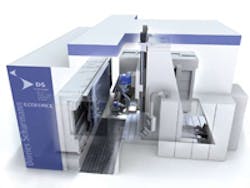As a material for use in aircraft construction, titanium meets the requirements of weight reduction. In addition, the trend within the aerospace industry to use carbon fiberenhanced compounds also requires the use of titanium because, chemically and mechanically, it is the ideal partner for such materials, especially for structural components and fittings.
Adding to this increase in titanium use is the fact that today’s aircraft manufacturers are under extreme pressure from international competition, so they demand efficient – extremely accurate and productive – machine technologies.
According to machine tool builder Dorries Scharmann Technologie GmbH (DST) (www.ds-technologie.de), high rigidity, damping and feed force are a must, and conventional tool-based machines, such as for separate roughing and finishing processes, are no longer suitable. Systems with vertical working spindles just can’t achieve the rate of chip removal at the machining performances required, and multiple spindles lack the necessary flexibility.
With these shortcomings in mind, Dorries Scharmann Technologie adopted a different approach when developing its new Ecoforce machining centers for titanium. Incorporating the use of proven modules, the new machines’ heads are automatically changeable via a pick-up magazine.
A 3-axis head rough cuts at speeds of 450 cubic cm/min (27.45 cu. in./min), and a 5-axis fork-type milling head finish cuts at 140 cubic cm/min (8.54 cu. in./ min). An internal 150-bar (2,175.5-psi) high-pressure cooling system further enhances the machine’s performance.
Pallets on the Ecoforce models 2035 and 2060 accommodate workpiece weights to 8,000 kg (8.8 tons) and 12,000 kg (13.2 tons), respectively. Vertical clamping pallets measure 3,500 mm (11.48 ft.) and 6,000-mm (19.68 ft.) wide and 2,000-mm (6.56 ft.) high.
Hydrostatic guides for the linear axes and on the B-axis turntable for the horizontal table group provide high machining capacity and high damping. Machine A axes rotate +/- 95 degrees, and the C axes are continuous 360 degrees.
For roughing, the 3-axis milling head pumps out 60 kW, 4,000 Nm at 2,000 rpm, while for finishing, the 5-axis head boasts 40 kW, 1,000 Nm and 5,000 rpm. A Wero tool magazine holds as many as 210 tools to keep the milling heads well supplied with tooling.
In operation, machine pallets travel out of the workstation for loading and unloading, operations made easier since the system swivels to a horizontal position. As an option, and depending on workpiece geometry, the machines can be built with horizontal table groups and pallet changers.
